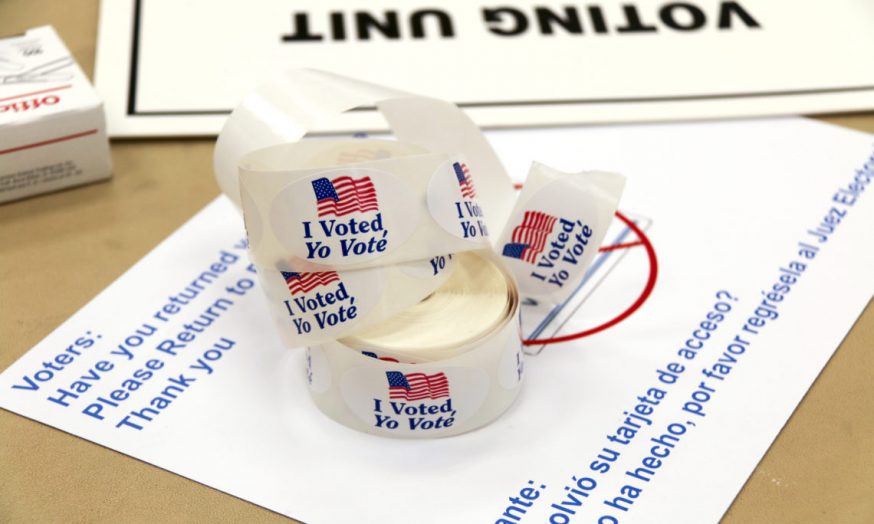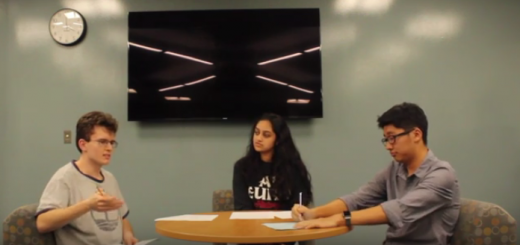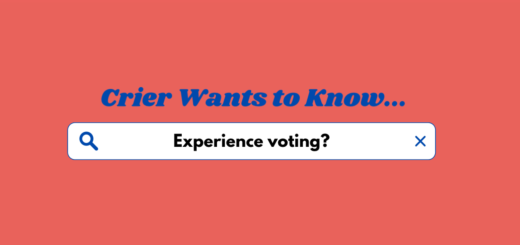Behind the scenes: the high school election judge experience
 Creative Commons Attribution-ShareAlike 2.0 Generic https://creativecommons.org/licenses/by-sa/2.0/
Creative Commons Attribution-ShareAlike 2.0 Generic https://creativecommons.org/licenses/by-sa/2.0/ “I voted” stickers in English and Spanish, Virginia, USA, November 2014. (Organization for Security and Co-operation in Europe (OSCE) photo.)
The 2020 presidential election has often been referred to as one of the most contentious elections in American history. As part of a generation that is too young to vote, yet simultaneously very involved and up to date in the nation’s political climate, we’ve been especially hyped for the election this year. The evidence is everywhere: from the news to Tik Tok For-You pages across the country.
Our names are Neela Gilbert and Nivi Krishnan, and we’re both juniors at Conant High School. Neither of us are voters yet, but we still wanted to be involved in this election. Therefore, we became high school election judges.
Election judges are responsible for signing in and registering voters on election day, which is the process of looking up their street number and last name, confirming their address is current, matching their signature in the label book, and getting them to their preferred paper or touchscreen ballot station. Judges also hand out ballots, set up all technology, and assist voters who need help voting. They work on pre-election day set up, as well as from 5AM-8PM on election day, and get paid $200.
Both of us learned about the opportunity in the same way: Sanjana Rajesh, a senior at Conant. She believes strongly in political involvement, especially for minorities, women, and the younger generations, and she encouraged both of us to take on this opportunity.
The Training Process
Because of the current pandemic, the training process was an online self-guided course. On average, it took us around two hours (Neela: or four hours, if you’re me) to complete the 39 lessons, consisting of videos, readings, and three quizzes. Overall, it felt like another online class we had to take, except we were getting paid (Neela: and it was better because there were no Zooms!) (Nivi: seconded).
It was recommended for us to not complete it in one sitting, and even though we took this advice, we were still feeling overwhelmed with the amount of labels, seals, and ballot types we needed to know. One positive of the experience was that each video lesson was 5 minutes max, making the content digestible in adequate doses.
Though the training itself was online, we were offered an optional practice session where we could go through the motions of checking in voters with a trainer and get comfortable with the equipment we would be using. Equipment that judges use include VSC (voting supply carrier), which contains the ballot scanner, E-Poll Books, voting touchscreens, ballots, and office equipment. E-Poll Books are computers programmed with VoteSafe, the program used by election judges to check in voters and register new ones. The E-Poll Books have a label printer, ID scanner, and portable WiFi attached for ease when checking in voters.
In the Old Orchard Country Club Banquet hall (Nivi: which, by the way, smelled like expensive perfume), we were surrounded by E-Poll Books, VSC boxes, and election day manuals.
Because the classes were split up to avoid a large group of people in the room, we were only allowed one hour of practice. Regardless of this time constraint, the extra practice was nonetheless very helpful. Online training is better than nothing, but as our fellow Cougars know, in person learning in a classroom (in our case, a bare banquet hall) beats any video.
There’s a stigma that election judges are elderly, but at least in our case, a variety of age ranges were represented. In our practice group of eleven, four (including the two of us) were teenagers, two were in their 30s, a couple in their 50s, and the rest senior citizens, with the overall population being overwhelmingly female.
Our trainer was welcoming and nice, with the air of someone who knew what she was doing, and she nmoved with confidence. In fact, she told us she had been training for 12 years, which was good for two teenagers whose only election experience was getting an extra “I Voted” sticker after accompanying their parents to the polls.
Vasu Janjrukia’s Experience
We were surprised to add yet another Crier staff member to our first-time election judge ranks. We discovered that Vasu Janjrukia, a fellow junior and Crier staff member, was also serving at our polling station.
“To be completely honest, my main motivation was seeing that check,” Janjrukia said. “It sounded like a pretty good first job to get. Supporting democracy and getting paid to do so sounds like a win-win situation. I first found out on the school district website that this was a thing that I could do, and so here I am.”
The Night Before Election Day
On Nov. 2, the three of us congregated at the Nerge Elementary School gym for pre-election set up; this was when we finally learned what the day would look like. Vasu was an EJ (election judge) for precinct 73 (a district of a town separated by political boundaries), while the two of us were both EJs for precinct 67. As such, we didn’t work together too much throughout the day, though we did see each other quite a bit.
The large majority of EJs at our polling place were also going through the experience for the first time, and let’s just say there was no shortage of confusion. Even though we had massive spiral-bound manuals guiding our every move, it was easy to forget to write down a seal number or make mistakes on the VoteSafe application. (Nivi: It didn’t help that all the equipment was old as time. Or, at least, from 2008). Luckily, any and all mistakes we made seemed to be fixable, and we only became more familiar with the materials throughout the night before the election.
In our precinct, we had three other EJs working with us. We had two middle-aged women who were also new to the experience. They treated us like we were their kids, calling us “sweetie” or “honey”, but they also respected our ideas, which was really refreshing coming from two adult strangers. Both of them easily fell into their roles; not to mention, they kept us from screwing up and completely destroying the fabric of American democracy (a distinct possibility). Every time one of us had a question, they always had an answer ready to go.
We also met our lead EJ and PPT (polling place technician), an older man who’d worked in previous elections as well as early voting polls for the five weeks leading up to election day. Without him, we would have been operating in the dark for most of the technological difficulties we faced both before and during election day. (Neela: He saved Nivi multiple times, as she didn’t know what the windows WiFi icon looked like) (Nivi: Okay for the record, he saved us both. And the WiFi thing was only an issue twice).
Election Day
As election judges, we had to be at the polling center by 5 AM, which means we were basically forced to buy iced coffee from Dunkin’ to start our day (which we did). Our day ended at 8 PM, when we left absolutely exhausted, with firsthand experience of the 2020 election and a $200 check.
The polls opened at 6 AM, and the ensuing morning rush (which was really only 20 people, tops) made things hectic due to an array of problems. Not only did one of our check-in stations break down, but one of our touchscreens was also out of commission. (Nivi: Neela handled most of the morning rush, while I dealt with a single voter for close to a half hour as her glare–due to my perceived ineptitude–seared into my soul. Of course, that’s an exaggeration, but it was kind of terrifying.)
Throughout the day, we came to realize that our precinct actually had the best luck when it came to technology: both of our check-in stations were–usually–working, and we managed to fix our second touchscreen. However Vasu’s precinct was a different story.
“We were lucky to even open,” he said. “We had to use one ePollbook, and our touch screen wouldn’t work, so we had to give everyone paper ballots. Luckily we weren’t too busy, but we also knew that if our other ePollbook decided to start having issues, no one in that precinct could vote.”
Our Worst Run-Ins
Neela: It was about 8AM on Election Day, and I was already ready to leave. Running on 6 hours of sleep and half an iced coffee (would recommend with oat milk), the morning rush had started, and I was experiencing my most difficult voter of the day: an intimidating woman who came into the polling station with gusto.
In this case, the woman was wearing a neck black gaiter with “TRUMP 2020” printed on it. For context, wearing anything whether it be a shirt or mask that has an explicit political message, such as “Trump 2020” or “Biden 2020,” is electioneering and not allowed. Election judges are instructed to ask voters with such merchandise to remove it or cover it, for the sake of prohibiting them from intimidating other voters.
Being the shy person I (sometimes) am, I was scared to ask her to cover it as she had already given me an evil eye for taking too long to check her in. As I finished checking her in, an election judge was loudly congratulating a person who had voted for the first time by saying, “Thank you for taking part in this democratic process!”
The woman watched the scene, and whipped back around towards my fellow election judge (let’s call her Judge C) and complained that the judge was being partial to the Democratic Party. Judge C and I said nothing, as we had other voters to check in and didn’t feel like getting involved. The lady walked over to the touch screen, where our PPT asked her to flip her neck gaiter so it did not have a political message, as he explained it was illegal.
She started ranting about how the election judge previously endorsed the Democratic Party, but she wasn’t allowed to wear a political message. I respectfully responded with, “That judge said democratic process, not party”, which just gave her more fuel as she started arguing over what she heard. Honestly, I was surprised a woman who was VOTING didn’t know what the democratic process was.
Overall, my experiences were not as traumatizing as they were to Nivi. I work part time at a fast food restaurant, and I’m used to rude customers who want things done ASAP, even when that isn’t possible. Honestly, the day was like working at my job, a few angry customers here and there, but mostly pleasant interactions.
Nivi: At exactly the same time (because all fires must burn together), I dealt with one of my particularly bad run-ins. The morning rush was thinning out, and my E-Poll Book check-in station was finally back in working order; in other words, I was beginning to feel optimistic about our day, which of course was when everything went wrong.
When I beckoned a particular gentleman forward, the day went out the window when I looked up this man’s address to find that it did not exist. I looked up with a smile, offering to register him to vote. To put simply, he was not pleased. He insisted that he was registered to vote, and that his information was clearly in the system.
Turned out, he was sent to this precinct by Vasu, who had looked him up and found him in our precinct (thanks a lot, Vasu). I would like to disclaim that the man showed remarkable patience initially, as I was forced to walk him back and forth to the multiple precincts in the gym.
However, when his patience ran out, he began to throw his weight around. He accused me of voter suppression, and threatened to sue me. He threatened to report our precinct and get us audited. To make it perfectly clear, we updated him on all the courses of action we were taking, and he was able to see for himself the discrepancy in the system.
For a newbie at the very beginning of the day, this encounter honestly shook me for a little. It also opened my eyes to just how rude potential voters could be for the rest of the day, and how unlikely they were to cut volunteers some slack.
However, as the day went on, I learned that there were more patient voters than impatient ones, and the mistakes I made helped me learn to be more efficient and troubleshoot better.
Not to mention, I understood that I should strive for perfection: while mistakes were always possible, my job was to get them in and out in the most efficient way possible. Learning to do it well over the hours allowed for a serious sense of accomplishment.
Our Best Run-ins!
Even though we had our fair share of stressful experiences, our amazing experiences definitely countered them.
At the very beginning of the day, an extremely good-humored couple cracked jokes the entire time they stood in line, and talked about how over the years they always went to vote as a couple. Both of us were still nervous, and they helped quell our nerves spectacularly.
Even with the best voters we met, all kind, compassionate and humorous, nothing was quite as fulfilling as registering new voters for their first election. We both received many immigrants who had recently become naturalized citizens.
Nivi: Especially for me, registering Indian immigrants who had just gotten their passports was an amazing feeling. It felt like finally paying forward the citizenship I had received at birth. They were always so excited to vote for the first time, and brandished their “I Voted” stickers like a badge of honor (which it absolutely is).
We were also able to register multiple teenagers who had just turned eighteen or had turned eighteen over the past couple years. They were always our favorite voters because we were alike in our sheer confusion and were always able to find common ground in our social awkwardness. (Nivi: I always found it a bit ironic that Neela and I were the ones registering them to vote that day, and we couldn’t even vote.)
Around 5 PM, our personal favorite voter came into the precinct. She’d turned 18 five days prior to election day and was relying on Illinois’ Election Day Registration to get her ballots. I was helping her register, but both of us worked together on her particular case. She needed to provide two forms of valid ID, but one of her ID materials wasn’t accepted. Her mother worked with the two of us to pull up various forms of identification until we were finally able to register her as a valid voter in our precinct. We were rooting for her as her ballots were stamped and initialed to when she eventually fed them through the scanner.
Closing Election Day
After the polls closed at 7PM, we were honestly dead on our feet. However, we still had quite a bit to do. We had privacy stations to pack up, statements to sign, seals to record, and E-Poll Books to shut off. Our PPT took care of the most important actions, like making sure each ballot was counted by the scanner, and the results were projected and printed correctly; we mostly folded up chairs and tables.
Our most important action was witnessing him confirm the Statement of Ballots, a count of the total votes. We confirmed our hours worked on the payroll, thanked the other judges, and finally were able to go home.
As we entered the house (Nivi: my house, since it was closest to our precinct) we almost groaned with the realization that we left our coats at the polling place, and were forced to return one last time for the day. In hindsight, it feels only fitting that the day ended with one last problem to troubleshoot.
Conclusion
Even a week after our election judge experience, we can honestly say that it’s one of the coolest things we’ve done with our lives. Though our initial motivations were varied, we would both enjoy repeating this experience in a future election, especially now that we won’t be quite as confused with our roles.
Being a part of the democratic process on such a historic day gives us and every other election judge across the country unique stories to tell, as well as new perspectives on America’s election process and a soft post for future election volunteers.
And perhaps the greatest takeaway?
Both of us are now well-prepared to vote in our first elections in the coming years.




Great experience and you both learned a lot. Plus you got confidence in handling various types of peoples.